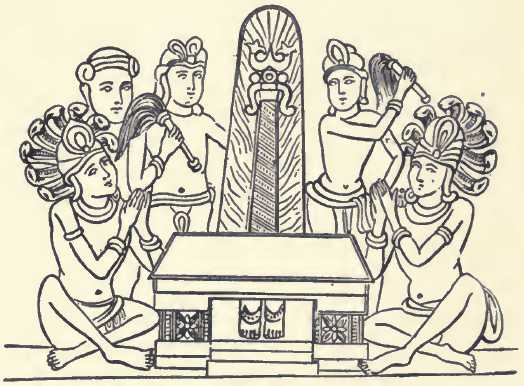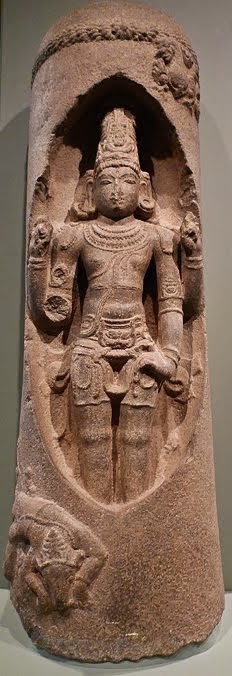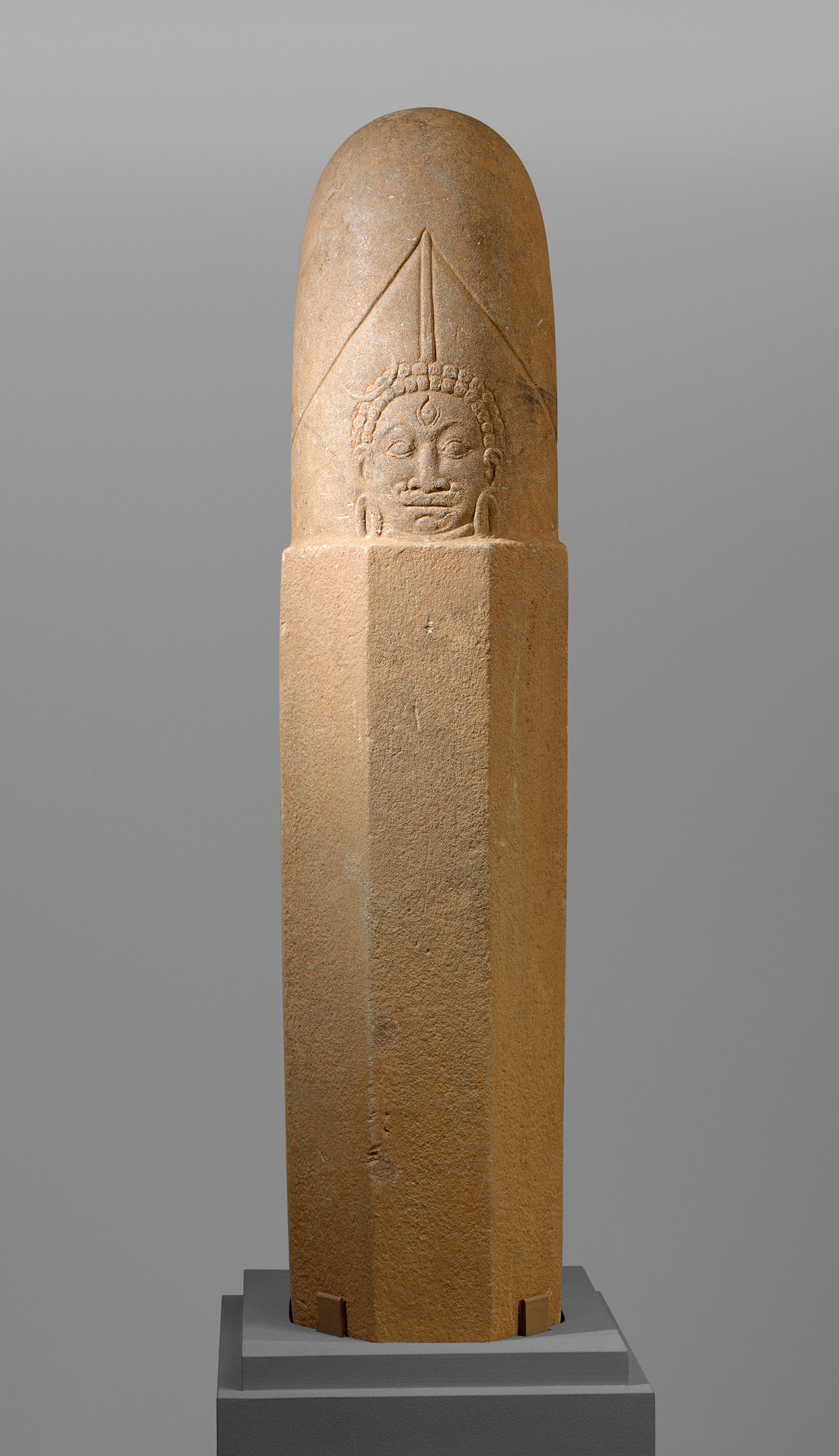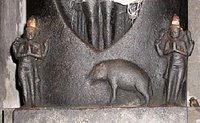Mirror: http://tinyurl.com/pgorkyo
Some scholars have advanced erroneous arguments suggesting non-Aryan phallus worship to explain the traditions of linga worship. Such arguments run counter to the references to jyotirlinga temples for worship of Sivalinga as fiery pillar of light as detailed in the Atharva Veda Skambha Sukta. Archaeological evidence, iconograhic evidence from scores of temples and evidence from Indus Script cipher to decipher the Candi Suku Sivalinga are presented to counter such fallacious arguments.
The chronology of Hindu tradition from the days of Atharva Veda is that iconic form of Mahesvara Siva emerges out of the aniconic Skambha (linga) or pillar of light and fire. What we find in the seven Sivalingas of Harappa is the aniconic form. Sivalinga appeared as a flame. Brahma, as hamsa, searches for the end in the heavens. Vishnu, as Varaha, searches for the beginning in the bowels of the earth. This Lingodbhava narrative is in many Puranas.
Appar, Shaiva saint of the 7th century, provides a similar narrative for this Lingodbhava. Tirugnana Sambandar refers to Brahma and Vishnu who set out on a search and comprehend Siva as the nature of light.
I submit that the most abiding form of worship is that which is displayed architecurally in Amaravati where Naga venerate the Skambha, the fiery pillar of light with the adornment of Srivatsa as the capital. The Srivatsa is a Indus Script hieroglyph of a pair of fish-tails: dula 'pair' Rebus: dul 'cast metal' Kur. xolā tail. Malt. qoli id. (DEDR 2135) The hooded snake which adorns as headgear is also read rebus: kula 'hooded snake' M. khoḷ f. ʻ hooded cloak ʼ(CDIAL 3942) A. kulā ʻ winnowing fan, hood of a snake ʼ(CDIAL 3350) Rebus: kol 'working in iron' kolle 'blacksmith' kolhe 'smelters'.
 Naga worshippers of fiery pillar, Amaravati stup Smithy is the temple of Bronze Age: stambha, thãbharā fiery pillar of light, Sivalinga. Rebus-metonymy layered Indus script cipher signifies: tamba, tã̄bṛā, tambira 'copper'
Naga worshippers of fiery pillar, Amaravati stup Smithy is the temple of Bronze Age: stambha, thãbharā fiery pillar of light, Sivalinga. Rebus-metonymy layered Indus script cipher signifies: tamba, tã̄bṛā, tambira 'copper' 
http://bharatkalyan97.blogspot.in/2015/05/smithy-is-temple-of-bronze-age-stambha_14.html
Railing crossbar with monks worshiping a fiery pillar, a symbol of the Buddha,
The iconographic signifiers of linga are consistent with the early semantics of linga which relate to: लिङ्ग[p= 901,3] n. (once m. in Nr2isUp.; ifc. f(आ)., f(ई).
only in विष्णु-लिङ्गी ; prob. fr. √ लग् ; cf. लक्ष , लक्षण) a mark , spot , sign , token , badge , emblem , characteristic (ifc. = तल्-लिङ्ग , " having anything for a mark or sign ") Up. MBh. &c. Linga as meaning 'organ of generation' occurs in Mn. Hariv. Pur. &c. The context of Atharva Veda Skambha Sukta is NOT in reference to linga but as a pillar of light, jyotis or a लक्षण of light or fire. The linga as an Indus Script hieroglyph has been explained in the context of Candi Suku iconography of four balls at the tip of a 6 ft. tall linga as a cipher for lokhāṇḍā, 'metal tools, pots and pans of copper'.
http://bharatkalyan97.blogspot.in/2015/09/bronze-age-lokhnda-metal-tools-pots.html Some scholars cite RV 7.21.5 and RV 10.99.3 references to s'is'nadeva as a reference to 'phallus worshippers'. This view is in error and will be explained based on Sayana's translations of the Rigvedic rica-s.
RV 7.021.05 Let not th ra_ks.asas, Indra, do us harm; let not the evil spirits do harm to our progeny, most powerful (Indra); let the sovereign lord, (Indra), exert himself (in the restraint) of disorderly beings, so that the unchaste may not disturb our rite. [Let not the ra_ks.asas: na vandana vedyabhih = vandana_ni, ra_ks.a_m.si, prajabhyah; the unchaste: s'is'nadevah, abrahmacharya ityarthah (Yaska 4.19)].
RV 10.099.03 Going to the battle, marching with easy gait, desiring the spoil, he set himself to the acquisition of all (wealth). Invincible, destroying the licentious, he won by his prowess whatever wealth (was concealed in the city) with the hundred gates. [s'is'nadeva_n is a tatpurus.a compound; hence, the meaning would perhaps be: incontinent or licentious].
Gopinatha Rao erroneously interprets s'is'na as non-aryans, phallus-worshippers "The worship of the Phallus which the non-Aryans of India shared with other nations who inhabited on the borders of the Mediterranean sea, has survived in India to this day. The Dhruvaberas in all Siva temples is the Linga surmounted upon the Yoni or the piNDika (pedestal). It is only in very rare instances we meet with the anthropomorphic representations of Siva set up as the principal deity in Siva temples. This non-Aryan phallic emblem seems to have been identified at a later period with Skambha of the Vedas, wherein Skambha is conceived as co-extensive with the universe and comprehends in him the various parts of the material universe, as also the abstract qualities, such as tapas, faith, truth and divisions of time. He is distinct from Prajapati, who founds the universe upon him...The gods who form part of him do homage to him."(pp.55-56 opcit.) This interpretation is based on the meaning given to s'is'na: शिश्न [p= 1076,3] m. n. (cf. शिशन् ; said to be fr. √ श्नथ् , " to pierce ") a tail , (esp.) the male generative organRV. &c.
Gopinatha Rao has erred because, following Yaska, Sayana interprets s'is'nadeva of both these ricas as unchaste men. Durgacharya also applies the word to those who dally carnally with prostitutes, forsaking Vedic observances. The veneration of Skambha an aniconic form of Mahesvara is NOT related to Skambha as a शिश्न but the jyotirlinga, the pillar of fire and light as the primordial explanation for the phenomena of the Universe like an axis Mundi linking earth and heaven.
'Skambha in the beginning shed forth that gold (hiraNya, out of which HiraNyagarbha arose) in the midst of the world.' This passage in the Skambha Sukta of Atharva Veda DOES NOT 'pour forth his golden seen in begetting Prajapati' as interpreted wrongly by Gopinatha Rao but explains the term HiraNyagarbha in relation to Skambha. The word vetasa used in the Sukta refers to a reed and NOT to a membrum virile, vetasa does NOT refer to an identity of the Linga, as wrongly interpreted by Gopinatha Rao who further adds: "At a later time a sort of philosophical clothing is given to the primitive Linga: by a section of scholars the LInga and its pedestal are viewed, with some justification, as the representation of the araNis, the two pieces of wood which were rubbed together by the Vedic Indian in making fire." I submit that this view of Gopinatha Rao is speculative with no basis in philology or tradition. Skambha is a pillar of light and fire and hence, the appellation Jyotirlinga given to the 12 holy sites of Siva temples in ancient India.


Image of Lingodbhava in the Airavatesvara Temple at Darasuram, 10th century CE
 Siva Lingodbhavamurti, Shiva apperaing in the falming linga, Tamil Nadu, Chola period, 12th-13th century, basalt. Musee Guimet.mg07 100112181 j r
Siva Lingodbhavamurti, Shiva apperaing in the falming linga, Tamil Nadu, Chola period, 12th-13th century, basalt. Musee Guimet.mg07 100112181 j r 
Shiva, Lingodbhava Story (Cave 16 Ellora)
Lingodbhava, the god rappers as a pillar of fire in the ocean; Brahma and Vishanu search for a beginning and Shiva for its beginning and end.
Lingodbhava, the god rappers as a pillar of fire in the ocean; Brahma and Vishanu search for a beginning and Shiva for its beginning and end.

Shiva the god as cosmic dancer.

 Siva as Lingodbhava Murti. c. 900 CE. Height: 138 cm (54.3 in). British Museum. Asia OA 1955.10-18.1
Siva as Lingodbhava Murti. c. 900 CE. Height: 138 cm (54.3 in). British Museum. Asia OA 1955.10-18.1Lingodbhava. Early Chola. http://www.jstor.org/stable/4422848

Siva as Lingodbhava, with Vishnu worshipping him. Thanjavur Brihadeesvara Temple

A second century BCE Lingodbhava cult of Lord Shiva, Gudimallam Chittoor district

Rajasimhesvara (Kailasanatha) Temple: ca. 730. West wall: Lingodbhava (Shiva emerging from the linga) & Linga installed in sanctum
Emerging from Jyotirlingam, Skambha of Light.
Lingodbhava. Tirumayam. Pudukkottai. Tamil Nadu

Lingodbhava, Virupaksha Temple, Pattadakal, Karnataka

Lingodbhava.

Linga with One Face of Shiva (Ekamukhalinga), Mon–Dvaravati period, 7th–early 8th century. Thailand (Phetchabun Province, Si Thep) Stone; H. 55 1/8 in.

Lingodbhava, Swarga Brahma temple, Alampur, Andhra Pradesh.

Arunachala.

Brahma flying up to find the top of the Column of Light

Vishnu burrowing downwards to find the bottom of the Column of Light

Siva Lingodbhavamurti. The Lingodbhavamurti, in which Siva is represented as Candrakasekhara emerging out of fiery Skambha Early Cola period (c. 850-1014CE.

Lingodbhava. Ellora.
Lingodbhavamurti. Stone. Dasavatara cave, Ellora. (After TA Gopinatha Rao, 1997, Elements of Hindu iconography, Vol.2, Pt.1, Delhi, Motilal Banarsidass, Plate XIV, Fig.1, p. 109)
Lingodbhavamurti. Stone. Ambar-Magalam. (After TA Gopinatha Rao, 1997, Elements of Hindu iconography, Vol.2, Pt.1, Delhi, Motilal Banarsidass, Plate XIV, Fig.2, p. 109)
Lingodbhavamurti. Stone. Lingodbhavamurti. Stone. Kailasanathaswamin Temple, Conjeevaram (After TA Gopinatha Rao, 1997, Elements of Hindu iconography, Vol.2, Pt.1, Delhi, Motilal Banarsidass, Plate XIII, Fig.1, p. 109)







